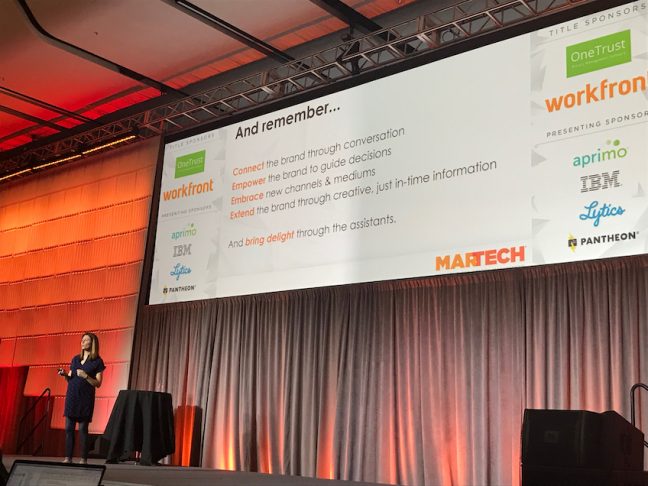A version of this article can also be found at Medium.
Last month nearly two thousand marketers gathered in San Jose California for MarTech, the leading conference in the Marketing Technology space. It was three days packed with learning and networking. The educational presentations were top notch. As the CEO of VoxSnap I need to be a thought leader in the audio and voice marketing industry, so I decided to write about the insights I took from the presentations related to Voice Assistants and Smart Speakers. It’s the new frontier in how people consume information.
1. The New Era of V-Commerce: What Marketers Need to Know about Alexa, Siri and the AI Revolution.
The speaker was Meg Goldthwaite CMO at NPR.
21% of adults in this country now own at least one Smart Speaker, according to the Smart Audio Report, Winter 2018.
There was an increase of 78% in the number of smart speakers in US households, from 66.7M in Dec 2017 to 118.5M in Dec 2018. That means a large audience is waiting to be engaged. Juniper research says that within 4 years 900M Virtual Assistant devices are going to be out there. That’s huge for a product category that didn’t even exist 4 years ago.
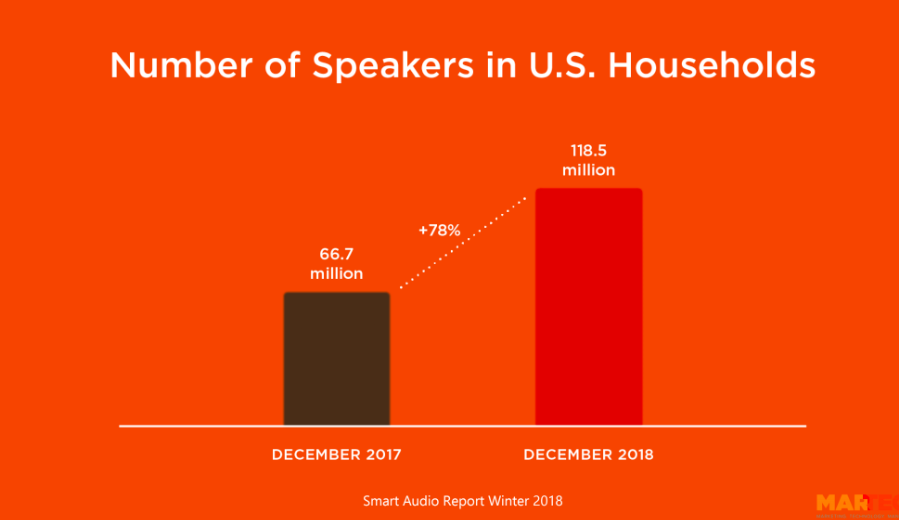
NPR’s mission, Meg says, is to reach as many people as possible with information and content. The technologies that have the biggest impact on NPR’s business right now are Smart Speakers like Amazon Alexa, Google Home, and Apple HomePod. Last year 19% of NPR’s streaming time was attributed to smart speakers. A year ago that was at 4%, so they saw 15% increase in just a year.
NPR creates content specifically for voice assistants. For example, their podcast The Indicator by Planet Money is a short, 5-7 minute quick and easy podcast for people who want to hear the latest in financial news. They can easily access that information through their Smart Speaker.
NPR also communicates and promotes to listeners the fact that they can access content through their designated Smart Speaker devices, because increasing awareness is very important.
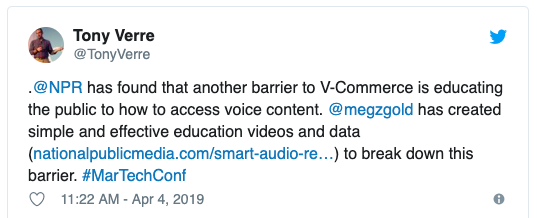


2. Marketing in the Age of Assistants
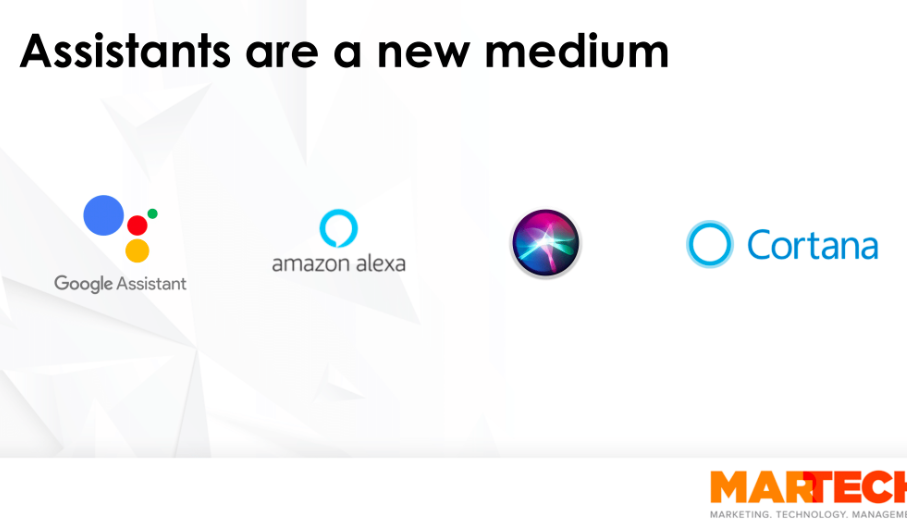
The speaker was Tricia DelGaudio, former Strategy Director at the Marketing Powerhouse Epsilon.
Tricia shared similar statistics about the market. She said “21% of people in the US now own a Smart Speaker. This is giant! That’s 53 million people. Last estimated census data was nearly 314 million people living in the US. So that’s a huge percentage of people that are actually inviting technology into their home from a voice standpoint.”
“Mary Meeker said it last year in her her 2013 report that voice technology is the fastest growing technology she’s ever seen. And that really surprises me because I was someone who was an early adopter of the iPod and the way that changed music from Walkman to actually having millions of songs in a small device. But now if we continue on that trajectory we have the cloud. There’s not a song that I can’t ask my smart assistant for that it won’t play. Last year alone 14 million new smart speaker owners entered the market, that’s a big number. These are users that we as marketers can start to engage with. The first Voice Assistant Speaker was released by Amazon in 2014. So in roughly four years they’ve taken almost just under a fifth of the market.”
Tricia showed a few examples of brands currently already taking advantage of smart speakers and voice assistants:
Campbell Kitchen

Campbell is a 150-year-old brand. They’ve been a really traditional brand but what they actually are able to do here through voice assistants is to empower their users and guide decisions.
With their Alexa Skill and Google Action, they have built their platforms to basically answer “What’s for dinner at Campbell’s?” I come home at night. I don’t know what’s for dinner. Somebody needs to help curate that for me. If I have chicken in the fridge I can go as specific as saying “Show me a recipe for chicken.” That’s a very curated response from them and it will serve me up with step-by-step recipes and even read them to me or show them to me if I have a screen with my voice assistant.
The clever move that Campbell has also made here is elevate their search. If I just asked my smart speaker to give me a chicken recipe, I’m going to hear other brands. But by inserting the brand and asking for a Campbell’s Chicken, they are able elevate their results.
Tide
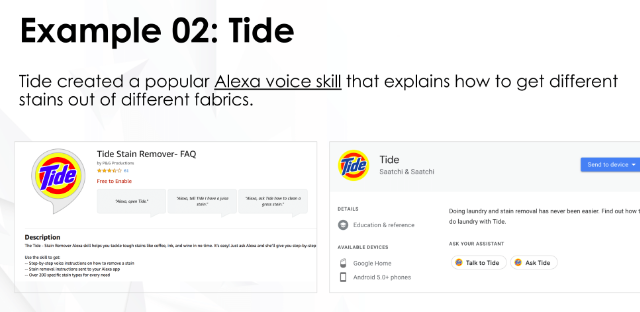
What Tide did here is choosing to embrace Smart Speakers as a channel. They built a skill that explains how to get different stains out of everything. In fact, there are 200 different stains that they can help remove. This way they enhanced the behavior of how I actually look for stain removal. I can say “Alexa, I have a juice stain” and the skill will take me through a conversation of what that stain is, what kind of fabric, etc. Through a decision tree, it will give me an answer. Now, previously I might have called my grandmother and she would tell me I could use dish soap or some other remedy, but she’s not necessarily available today. So they’ve given me a different channel from which I can reach that information.
Sparkling Ice

They are in a really interesting category because these sparkling ices are supposed to be a healthy beverage, natural flavored sparkling water. That particular category grew 54% in 2018. Tricia was on the marketing team at Epsilon in charge of creating the Smart Speakers strategy for Sparkling Ice. The Epsilon team came up with a great idea for their Skills and Actions to create cocktails that featured Sparkling Ice as the main ingredients versus an optional ingredient. They also took advantage of the screen in Smart Speakers, they put the product front and center for people.

So when users say “hey Google” or “Alexa, talk to Sparkling Ice,” the product is able to be ‘heard’ and ‘seen’. Users then interact by saying for example “Recommend me a drink. I don’t know what to add Sparkling Ice to.” Or they can say “I have black raspberry at home. I want black raspberry in my cocktail.” By having the voice app respond with relevant cocktails, Sparking Ice was able to create an experience that engages the audience further beyond just this healthy sparkling beverage and into an entertainment beverage.
Ultimately to create a successful brand experience for users, Tricia says look at it from a multi-platform perspective. Whether it’s Amazon Alexa or Google Home, it needs to be the experience of “I’m here at the right time, on the right device, and I’m here to help you”.
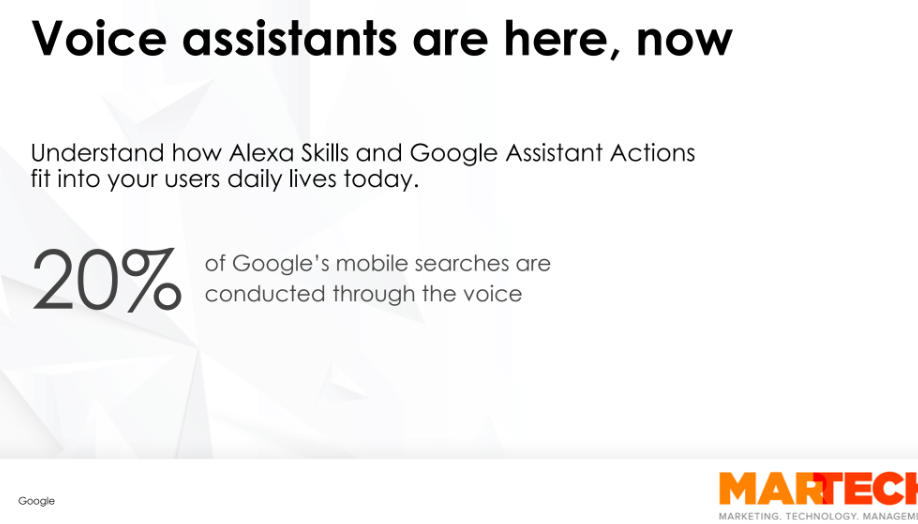
To conclude, voice assistants are here, they are now, and they’re not going to go anywhere. They’re going to continue to evolve and they are evolving quickly. Twenty percent of current mobile search is actually done via voice. That’s through our phones and that’s where the integration opportunities are. You can actually send the results to your Smart speakers, or to your other devices, and it’s going to keep growing.
If you’re going to build a Skill or an Action as a point of awareness and reach, focus on how it fits into a user’s life. These people are busy. They are moms and dads, they are working professionals, and students. They’re multitasking and they really want to make sure that what you’re offering them brings them value. That’s where brands right now can be building awareness.


